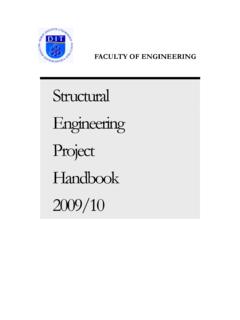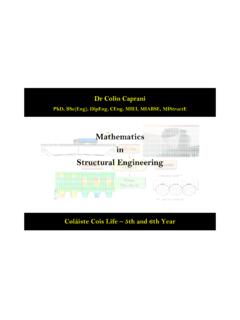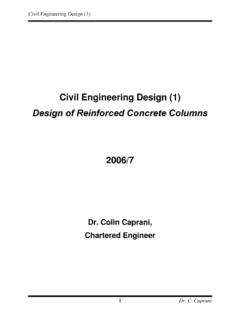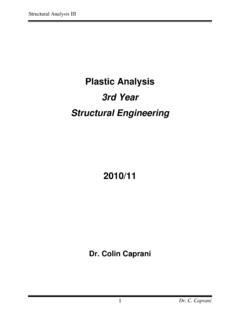Transcription of Chapter 4 - Matrix Stiffness Method - colincaprani.com
1 Structural Analysis IV Chapter 4 Matrix Stiffness Method Dr. C. Caprani 1 Chapter 4 - Matrix Stiffness Method Introduction .. 3 Background .. 3 Basic 4 Computer Programs to Support 6 Basic Approach .. 10 Individual Element .. 10 Assemblies of elements .. 12 Example 1 .. 14 General Methodology .. 20 Member contribution to global Stiffness Matrix .. 22 Interpretation of Stiffness Matrix .. 27 Restricting a Matrix Imposing Restraints .. 29 Plane Trusses .. 32 Introduction .. 32 Truss Element Stiffness Matrix .. 35 Element Forces .. 40 Example 2: Basic Truss .. 43 Example 3: Adding Members .. 52 Example 4: Using Symmetry .. 56 Self-Strained Structures .. 59 Example 5 Truss with Differential Temperature .. 63 Example 6 Truss with Loads & Self Strains .. 69 Structural Analysis IV Chapter 4 Matrix Stiffness Method Dr. C. Caprani 2 Problems .. 74 Beams .. 77 Beam Element Stiffness Matrix .. 77 Beam Element Loading .. 82 Example 7 Simple Two-Span Beam.
2 84 Example 8 Non-Prismatic Beam .. 88 Problems .. 92 Plane Frames .. 95 Plane Frame Element Stiffness Matrix .. 95 Example 9 Simple Plane Frame .. 104 Example 10 Plane Frame Using 109 Problems .. 115 Appendix .. 120 Plane Truss Element Stiffness Matrix in Global Coordinates .. 120 Coordinate Transformations .. 129 Past Exam Questions .. 137 References .. 148 Rev. 1 Structural Analysis IV Chapter 4 Matrix Stiffness Method Dr. C. Caprani 3 Introduction Background The Matrix Stiffness Method is the basis of almost all commercial structural analysis programs. It is a specific case of the more general finite element Method , and was in part responsible for the development of the finite element Method . An understanding of the underlying theory, limitations and means of application of the Method is therefore essential so that the user of analysis software is not just operating a black box . Such users must be able to understand any errors in the modelling of structures which usually come as obtuse warnings such as zero pivot or determinant zero: structure unstable: aborting.
3 Understanding the basics presented herein should hopefully lead to more fruitful use of the available software. Structural Analysis IV Chapter 4 Matrix Stiffness Method Dr. C. Caprani 4 Basic Concepts Node The more general name for a connection between adjacent members is termed a node. For trusses and frames the terms joint and node are interchangeable. For more complex structures ( plates), they are not. Element For trusses and frames element means the same as member. For more complex structures this is not the case. Degree of Freedom The number of possible directions that displacements or forces at a node can exist in is termed a degree of freedom (dof). Some examples are: Plane truss: has 2 degrees of freedom at each node: translation/forces in the x and y directions. Beams: have 2 degrees of freedom per node: vertical displacement/forces and rotation/moment. Plane Frame: has 3 degrees of freedom at each node: the translations/forces similar to a plane truss and in addition, the rotation or moment at the joint.
4 Space Truss: a truss in three dimensions has 3 degrees of freedom: translation or forces along each axis in space. Space Frame: has 6 degrees of freedom at each node: translation/forces along each axis, and rotation/moments about each axis. Structural Analysis IV Chapter 4 Matrix Stiffness Method Dr. C. Caprani 5 Thus a plane truss with 10 joints has 20 degrees of freedom. A plane frame with two members will have three joints (one common to both members) and thus 9 degrees of freedom in total. Local and Global Forces, displacements and Stiffness matrices are often derived and defined for an axis system local to the member. However there will exist an overall, or global, axis system for the structure as a whole. We must therefore transform forces, displacements etc from the local coordinate system into the global coordinate system. Structural Analysis IV Chapter 4 Matrix Stiffness Method Dr. C. Caprani 6 Computer Programs to Support Learning Matlab Truss Analysis Program Description To support the ideas developed here we will introduce some Matlab scripts at each point to demonstrate how the theory described can be implemented for computer calculation.
5 This collection of scripts will build into a program that can analyse pin-jointed trusses. The scripts will only demonstrate the calculations process, and do not have any graphical user interface facilities. This keeps the calculation process unencumbered by extra code. (In fact probably 90+% of code in commercial programs is for the graphical user interface and not for the actual calculations process.) Of course, this is not to say that graphical displays of results are unimportant; gross mistakes in data entry can sometimes only be found with careful examination of the graphical display of the input data. The scripts that are developed in these notes are written to explain the underlying concepts, and not to illustrate best programming practice. The code could actually be a lot more efficient computationally, but this would be at cost to the clarity of calculation. In fact, a full finite element analysis program can be implemented in under 50 lines (Alberty et al, 1999)!
6 It is necessary to use a scripting language like Matlab, rather than a spreadsheet program (like MS Excel) since the number of members and member connectivity can change from structure to structure. The program will be able to analyse plane pin-jointed-trusses subject to nodal loads only. It will not deal with member prestress, support Stiffness or lack of fits: it is quite rudimentary on purpose. Structural Analysis IV Chapter 4 Matrix Stiffness Method Dr. C. Caprani 7 Use To use the program, download it from the course website ( ). Extract the files to a folder and change the current Matlab directory to that folder. After preparing the data (as will be explained later), execute the following statement at the command line: >> [D F R] = AnalyzeTruss(nData,eData) This assumes that the nodal data is stored in the Matrix nData, and the element data Matrix is stored in eData these names are arbitrary. Entering the required data into Matlab will also be explained later.
7 Structural Analysis IV Chapter 4 Matrix Stiffness Method Dr. C. Caprani 8 TrussMaster To provide a bridge between the obvious workings of the Matlab program and the more black box nature of commercial programs, TrussMaster has been developed. This program can analyse plane trusses of any size. It has a front end that illustrates a fairly rudimentary commercial program interface, coupled with a back end (and some dialogs) that expose the calculations the program carries out. In this manner it is easy to link the hand calculations of the examples with the computer output, strengthening the link between theory and practice of the Method . TrussMaster is available on the college computers. The help file can be downloaded from the course website ( ). It will be used in some labs. Structural Analysis IV Chapter 4 Matrix Stiffness Method Dr. C. Caprani 9 LinPro LinPro is very useful as a study aid for this topic: for example, right click on a member and select Stiffness Matrix to see the Stiffness Matrix for any member.
8 The latest version ( ) has a very useful Study Mode , which exposes the structure and member Stiffness matrices to the user. A user familiar with the underlying theory can then use the program for more advanced purposes, such as spring supports, for example. You can download LinPro from Structural Analysis IV Chapter 4 Matrix Stiffness Method Dr. C. Caprani 10 Basic Approach Individual Element We consider here the most basic form of Stiffness analysis. We represent a structural member by a spring which has a node (or connection) at each end. We also consider that it can only move in the x- direction. Thus it only has 1 DOF per node. At each of its nodes, it can have a force and a displacement (again both in the x-direction): Notice that we have drawn the force and displacement vector arrows in the positive x-direction. Matrix analysis requires us to be very strict in our sign conventions. Using the basic relationship that force is equal to Stiffness times displacement, we can determine the force at node 1 as: ()1net displacement at 1Fk= Thus: ()1121 2Fk uukuku= = (4.)
9 Similarly for node 2: Structural Analysis IV Chapter 4 Matrix Stiffness Method Dr. C. Caprani 11 ()22112Fk uukuku= = + (4 . ) We can write equations ( ) and ( ) in Matrix form to get the element Stiffness Matrix for a 1-DOF axial element: 1122 FukkFukk = (4 . ) And using Matrix notation, we write: { }[ ]{ }ee=Fku (4 . ) Here: { }eF is the element force vector; [ ]k is the element Stiffness Matrix ; { }eu is the element displacement vector. It should be clear that the element Stiffness Matrix is of crucial importance it links nodal forces to nodal displacements; it encapsulates how the element behaves under load. The derivation of the element Stiffness Matrix for different types of elements is probably the most awkward part of the Matrix Stiffness Method . However, this does not pose as a major disadvantage since we only have a few types of elements to derive, and once derived they are readily available for use in any problem.
10 Structural Analysis IV Chapter 4 Matrix Stiffness Method Dr. C. Caprani 12 Assemblies of elements Real structures are made up of assemblies of elements , thus we must determine how to connect the Stiffness matrices of individual elements to form an overall (or global) Stiffness Matrix for the structure. Consider the following simple structure: Note that the individual elements have different stiffnesses, 1k and 2k. Thus we can write the force displacement relationships for both elements as: 1111211 2Fk kuFkk u = (4 . ) 22223322 FukkFukk = (4 . ) We can expand these equations so that they encompass all the nodes in the structure: 1 111211233000 00F kk uFkkuFu = (4 . ) 112222322 300 000 FuFk kuFkk u = (4 . ) Structural Analysis IV Chapter 4 Matrix Stiffness Method Dr. C. Caprani 13 We can add equations ( ) and ( ) to determine the total of both the forces and displacements at each node in the structure: 11 11211 22 232 2300Fk kuFkkk k uFk ku = + (4.)






